Attached files
| file | filename |
|---|---|
| 8-K - 8-K - BrightSphere Investment Group plc | omam-q3x2015earningsreleas.htm |
| EX-99.1 - EXHIBIT 99.1 - BrightSphere Investment Group plc | omam-2015930xpressreleasee.htm |

Q3 2015 Earnings Presentation November 4, 2015 Exhibit 99.2

│ Disclaimer 2 Forward Looking Statements This presentation may contain forward looking statements for the purposes of the safe harbor provision under the Private Securities Litigation Reform Act of 1995. Forward-looking statements are identified by words such as “expect,” “anticipate,” “may,” “intends,” “believes,” “estimate,” “project,” and other similar expressions. Such statements involve a number of risks, uncertainties and other factors that could cause actual results to differ materially from these forward looking statements. These factors include, but are not limited to, the factors described in OMAM’s filings made with the Securities and Exchange Commission, including our Form S-1, as filed with the SEC on June 8, 2015, as amended, under the heading “Risk Factors.” Any forward-looking statements in this presentation are based on assumptions as of today and we undertake no obligation to update these statements as a result of new information or future events. We urge you not to place undue reliance on any forward-looking statements. Non-GAAP Financial Measures This presentation may contain non-GAAP financial measures. A reconciliation of GAAP to non- GAAP measures is included in the appendix to this presentation.
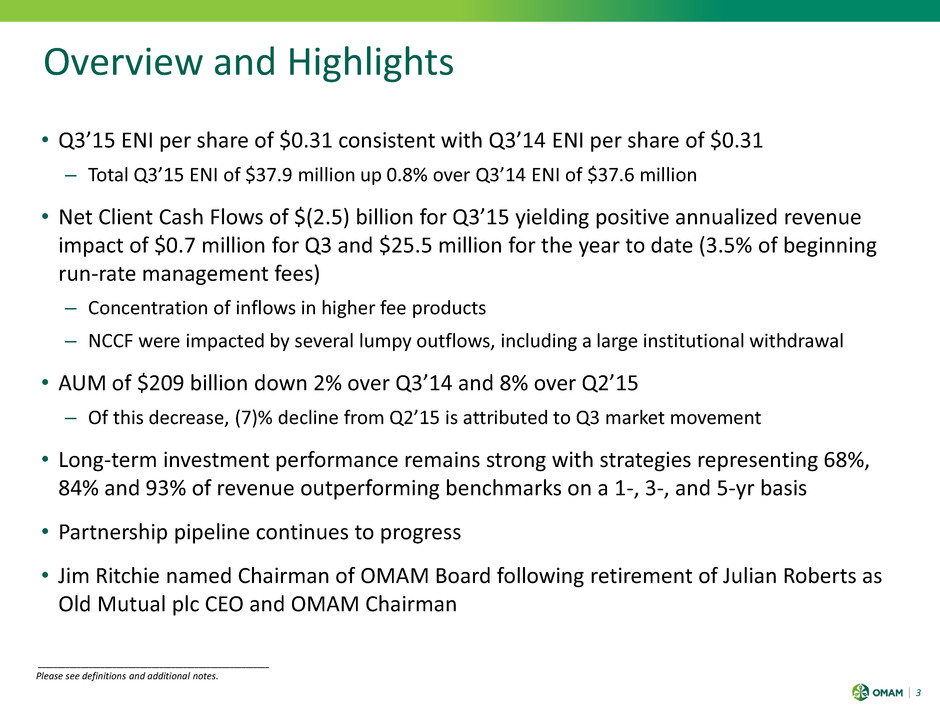
│ • Q3’15 ENI per share of $0.31 consistent with Q3’14 ENI per share of $0.31 ‒ Total Q3’15 ENI of $37.9 million up 0.8% over Q3’14 ENI of $37.6 million • Net Client Cash Flows of $(2.5) billion for Q3’15 yielding positive annualized revenue impact of $0.7 million for Q3 and $25.5 million for the year to date (3.5% of beginning run-rate management fees) ‒ Concentration of inflows in higher fee products ‒ NCCF were impacted by several lumpy outflows, including a large institutional withdrawal • AUM of $209 billion down 2% over Q3’14 and 8% over Q2’15 ‒ Of this decrease, (7)% decline from Q2’15 is attributed to Q3 market movement • Long-term investment performance remains strong with strategies representing 68%, 84% and 93% of revenue outperforming benchmarks on a 1-, 3-, and 5-yr basis • Partnership pipeline continues to progress • Jim Ritchie named Chairman of OMAM Board following retirement of Julian Roberts as Old Mutual plc CEO and OMAM Chairman ___________________________________________________________ Overview and Highlights 3 Please see definitions and additional notes.

│ Growth Strategy 4 OMAM’s multi-boutique model is well positioned for growth, with four key areas of focus… Please see definitions and additional notes. Global Distribution New Partnerships Collaborative Organic Growth (Growth and Seed / Co-Investment Capital) Core Affiliate Growth (Investment Performance and Net Client Cash Flows) OMAM’s Aligned Partnership Model - Affiliate-level employee ownership - Long-term perspective - Talent management - Operating autonomy - At-scale Affiliates - Profit-sharing model Four Key Growth Areas Unique Partnership Approach Provides Stability and the Foundation For Growth Multi-Boutique Value Proposition Drives Incremental Growth Opportunities ___________________________________________________________

│ AUM Progression and Mix 5 Please see definitions and additional notes. Net Flows AUM at Period End Market Appreciation (Depreciation) and Other As % of BoP AUM AUM Progression (Last 12 Months) $213.8 $208.7 $1.9 $(7.0) $150 $170 $190 $210 $230 Q3'14 Q3'15 0.9% -3.3% $B AUM Progression (3rd Quarter) $226.6 $208.7 $(2.5) $(15.4) $150 $170 $190 $210 $230 Q2'15 Q3'15 $B -1.1% -6.8% AUM Mix (9/30/15) ___________________________________________________________ AUM AUM by Affiliate $B % Total $66 32% 88 42% 7 3% 4 2% 28 13% 2 1% 14 7% Total $209 100% AUM AUM by Asset Class $B % Total U.S. Equity $75 36 Alternative, Real Estate & Timber 37 18 International Equity 34 16% Global Equity 28 13% Emerging Markets Equity 20 10% Fixed Income 15 7% Total $209 100%

│ 2015 Net Client Cash Flows and Revenue Impact 6 42 39 42 42 40 35 41 44 40 43 46 44 47 46 46 44 37 34 35 41 40 38 41 38 36 38 38 30 31 32 AUM Net Client Cash Flows (“NCCF”) Revenue Impact of NCCF(1) $B $M 2014 2012 2013 $10.5 $0.4 $9.5 2014 2012 2013 $42.5 $11.2 $54.5 2015 $(1.9) $25.5 $1.3 $(1.3) $0.3 $2.9 $3.4 $2.6 $1.7 $4.9 $(0.9) $5.5 $5.8 $6.1 $3.3 $3.9 $0.2 (1) Annualized revenue impact of net flows represents the difference between annualized management fees expected to be earned on new accounts and net assets contributed to existing accounts, less the annualized management fees lost on terminated accounts or net assets withdrawn from existing accounts, including equity-accounted Affiliates. Annualized revenue is calculated by multiplying the annual gross fee rate for the relevant account by the net assets gained in the account in the event of a positive flow or the net assets lost in the account in the event of an outflow. (2) Derived Average Weighted NCCF reflects the implied NCCF if annualized revenue represents asset flows at the weighted fee rate for OMAM overall (ie 34.5 bps in Q3’15). For example, NCCF annualized revenue impact of $0.7m divided by average weighted fee rate of OMAM’s overall AUM of 34.5 bps equals the derived average weighted NCCF of $0.2b. Bps inflows Bps outflows Derived Average Weighted NCCF ($b)(2) $1.2 $(1.4) $(1.0) $1.6 $3.0 $3.2 $1.0 $3.3 $(1.0) $3.6 $3.1 $3.8 $(0.2) $0.8 $(2.5) $(3) $(2) $(1) $- $1 $2 $3 $4 Q1 Q2 Q3 Q4 Q1 Q2 Q3 Q4 Q1 Q2 Q3 Q4 Q1 Q2 Q3 $4.5 $(4.4) $1.1 $10.0 $11.6 $8.6 $5.8 $16.5 $(3.0) $18.4 $19.1 $20.0 $11.3 $13.5 $0.7 $(5) $- $5 $10 $15 $20 Q1 Q2 Q3 Q4 Q1 Q2 Q3 Q4 Q1 Q2 Q3 Q4 Q1 Q2 Q3 ___________________________________________________________
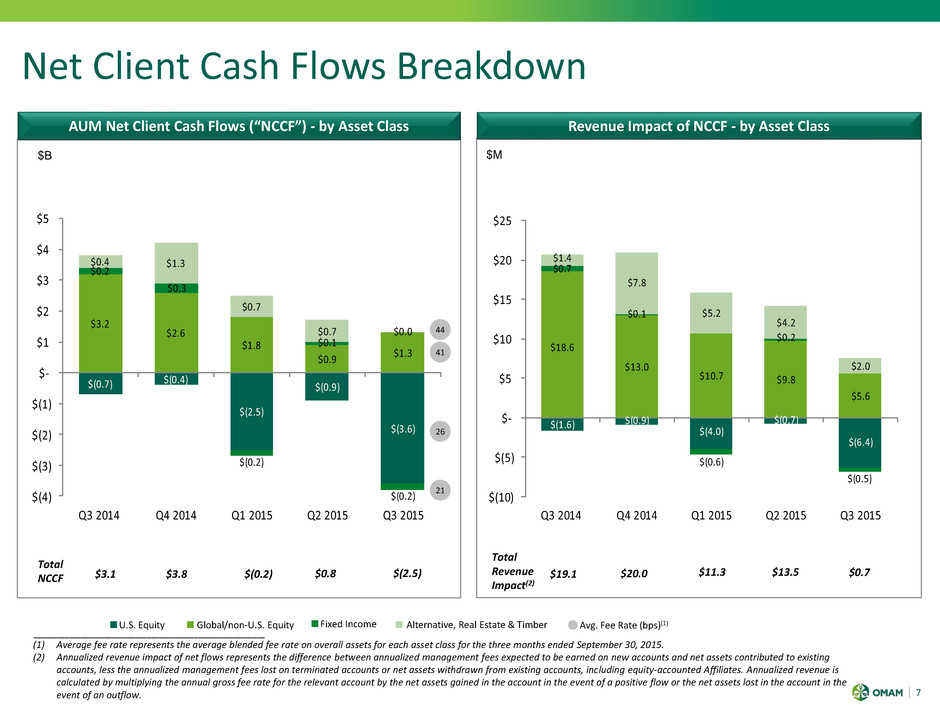
│ $(0.7) $(0.4) $(2.5) $(0.9) $(3.6) $3.2 $2.6 $1.8 $0.9 $1.3 $0.2 $0.3 $(0.2) $0.1 $(0.2) $0.4 $1.3 $0.7 $0.7 $0.0 $(4) $(3) $(2) $(1) $- $1 $2 $3 $4 $5 Q3 2014 Q4 2014 Q1 2015 Q2 2015 Q3 2015 Net Client Cash Flows Breakdown 7 AUM Net Client Cash Flows (“NCCF”) - by Asset Class Revenue Impact of NCCF - by Asset Class $B $M $3.1 $3.8 $(0.2) $0.8 $19.1 $20.0 $11.3 $13.5 Total NCCF Total Revenue Impact(2) (1) Average fee rate represents the average blended fee rate on overall assets for each asset class for the three months ended September 30, 2015. (2) Annualized revenue impact of net flows represents the difference between annualized management fees expected to be earned on new accounts and net assets contributed to existing accounts, less the annualized management fees lost on terminated accounts or net assets withdrawn from existing accounts, including equity-accounted Affiliates. Annualized revenue is calculated by multiplying the annual gross fee rate for the relevant account by the net assets gained in the account in the event of a positive flow or the net assets lost in the account in the event of an outflow. U.S. Equity Global/non-U.S. Equity Fixed Income Alternative, Real Estate & Timber Avg. Fee Rate (bps)(1) 21 41 26 44 ___________________________________________________________ $(2.5) $0.7 $(1.6) $(0.9) $(4.0) $(0.7) $(6.4) $18.6 $13.0 $10.7 $9.8 $5.6 $0.7 $0.1 $(0.6) $0.2 $(0.5) $1.4 $7.8 $5.2 $4.2 $2.0 $(10) $(5) $- $5 $10 $15 $20 $25 Q3 2014 Q4 2014 Q1 2015 Q2 2015 Q3 2015
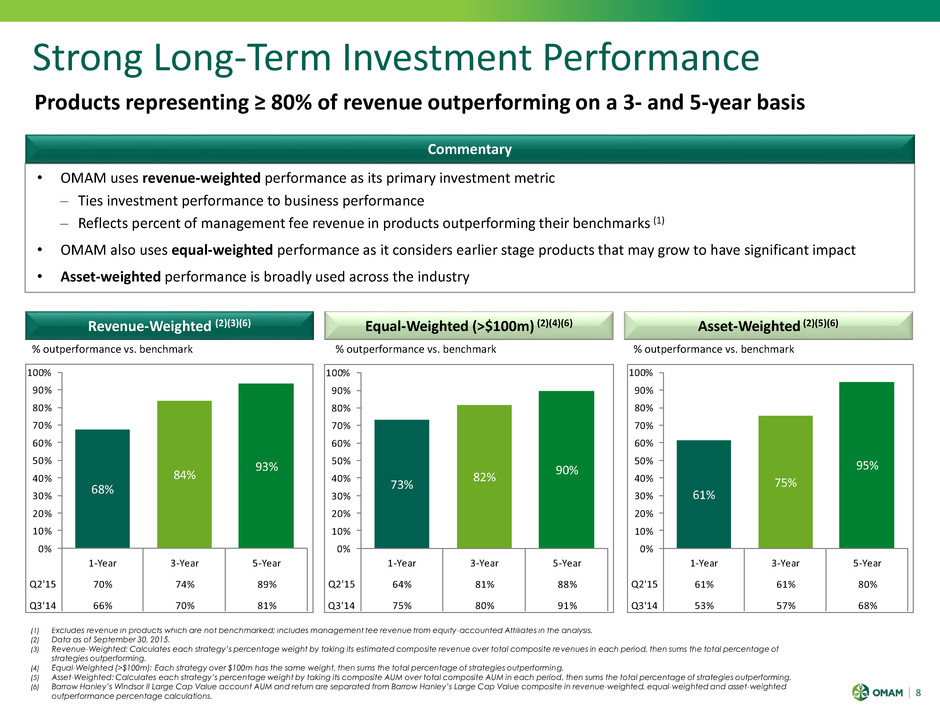
│ Strong Long-Term Investment Performance 8 • OMAM uses revenue-weighted performance as its primary investment metric ‒ Ties investment performance to business performance ‒ Reflects percent of management fee revenue in products outperforming their benchmarks (1) • OMAM also uses equal-weighted performance as it considers earlier stage products that may grow to have significant impact • Asset-weighted performance is broadly used across the industry Commentary Equal-Weighted (>$100m) (2)(4)(6) Asset-Weighted (2)(5)(6) Revenue-Weighted (2)(3)(6) Products representing ≥ 80% of revenue outperforming on a 3- and 5-year basis ___________________________________________________________ (1) Excludes revenue in products which are not benchmarked; includes management fee revenue from equity-accounted Affiliates in the analysis. (2) Data as of September 30, 2015. (3) Revenue-Weighted: Calculates each strategy’s percentage weight by taking its estimated composite revenue over total composite revenues in each period, then sums the total percentage of strategies outperforming. (4) Equal-Weighted (>$100m): Each strategy over $100m has the same weight, then sums the total percentage of strategies outperforming. (5) Asset-Weighted: Calculates each strategy’s percentage weight by taking its composite AUM over total composite AUM in each period, then sums the total percentage of strategies outperforming. (6) Barrow Hanley’s Windsor II Large Cap Value account AUM and return are separated from Barrow Hanley’s Large Cap Value composite in revenue-weighted, equal-weighted and asset-weighted outperformance percentage calculations. % outperformance vs. benchmark % outperformance vs. benchmark % outperformance vs. benchmark 68% 84% 93% 0% 10% 20% 30% 40% 50% 60% 70% 80% 90% 100% 1-Year 3-Year 5-Year 70% 74% 89% 66% 70% 81% Q2'15 Q3'14 73% 82% 90% 0% 10% 20% 30% 40% 50% 60% 70% 80% 90% 100% 1-Year 3-Year 5-Year 64% 81% 88% 75% 80% 91% Q2'15 Q3'14 61% 75% 95% 0% 10% 20% 30% 40% 50% 60% 70% 80% 90% 100% 1-Year 3-Year 5-Year 61% 61% 80% 53% 57% 68% Q2'15 Q3'14

│ • Q3’15 Economic Net Income up 0.8% to $37.9 million from $37.6 million in Q3’14 ‒ Positive impact of higher management fees, partially offset by public company expense and increases in core general and administrative expenses • ENI Revenue increase of 4% to $166 million from $159 million in Q3’14 ‒ Flat average assets (excluding equity accounted Affiliates) drive a 4% rise in management fees to $158 million for Q3’15 ‒ Increase of Q3’15 asset yield to 33.3(1) bps driven by flows and market appreciation in higher yielding assets • Expense growth of 7% to $105 million from $98 million in Q3’14 impacted by sales based compensation and public company expense ‒ Core operating expenses up 7% to $53 million (excludes sales based compensation and public company expense) ‒ Variable compensation up 3% to $45 million, remaining steady at 42% of earnings before variable compensation ‒ Total public company expense (including operating and variable comp) of approximately $2.7 million in Q3 ‒ Key ENI expense ratios in line with expectations • ENI Operating margin (before Affiliate key employee distributions) of 36.7% slightly reduced from 38.1% in year ago quarter ‒ Public company expenses negatively impact operating margin by approximately 1.6% in Q3 • Adjusted EBITDA rises 4% to $53.3 million from $51.1 million in Q3’14 • Revolving credit facility debt of $70 million at September 30 represents 0.3x adjusted LTM EBITDA • S-3 shelf for $2 billion of securities filed November 4 ___________________________________________________________ Please see definitions and additional notes. (1) Excludes Equity-Accounted Affiliates. Financial Highlights – Q3 2015 9

│ $M Steady Results in a Volatile Market 10 $216 $218 $222 $227 $219 $25 $50 $75 $100 $125 $150 $175 $200 $225 $250 Q3'14 Q4'14 Q1'15 Q2'15 Q3'15 (1) ENI Revenue consists of management fees, performance fees, and other income, which primarily consists of earnings of our equity-accounted Affiliates. (2) ENI Operating Margin represents ENI operating margin before Affiliate key employee distributions. This is a non-GAAP efficiency measure, calculated based on earnings after variable compensation divided by ENI Revenue. (3) ENI per share is calculated as Economic Net Income divided by total diluted shares outstanding. ENI per share reflects pro forma shares outstanding in periods prior to Q4’14. (4) Includes Equity-Accounted Affiliates. (5) Excludes impact of extraordinary performance fee. Pre-tax ENI(5) Average AUM(4) ENI Revenue(1) (5) Fee Rate (Basis Points)(4) $B $M Performance Fees ENI Operating Margin(2) (5) ENI Per Share(3) % Change Q3’14 to Q3’15: 1% % Change Q3’14 to Q3’15: 4% $49 $63 $51 $52 $51 $0 $10 $20 $30 $40 $50 $60 $70 Q3'14 Q4'14 Q1'15 Q2'15 Q3'15 % Change Q3’14 to Q3’15: 3% 33.1 32.9 34.0 34.3 34.5 20.0 25.0 30.0 35.0 40.0 Q3'14 Q4'14 Q1'14 Q2'15 Q3'15 38% 41% 37% 38% 37% 0% 7% 14% 21% 28% 35% 42% Q3'14 Q4'14 Q1'15 Q2'15 Q3'15 ___________________________________________________________ $0.31 $0.39 $0.31 $0.41 $0.31 $0.00 $0.10 $0.20 $0.30 $0.40 $0.50 Q3'14 Q4'14 Q1'15 Q2'15 Q3'15 Extraordinary Performance Fee $156 $155 $160 $167 $163 $159 $184 $163 $168 $166 $0 $50 $100 $150 $200 Q3'14 Q4'14 Q1'15 Q2'15 Q3'15 % Change Q3’14 to Q3’15: 0% $0.32 $0.09

│ ___________________________________________________________ Key Drivers of Financial Performance 11 Economic Net Income (“ENI”) reflects the underlying economic earnings of the business (1) See Slide 18 for a reconciliation of GAAP to ENI. Moderate revenue growth: High quality, recurring management fees, impacted by volatile market Financial Highlights (1) Expense management: Investment in the business and public company expenses offset by scale in variable compensation Affiliate equitization complete: Benefit from repurchase of Affiliate equity in Q4’14 Lower tax rate: Estimated to be 27-30% 2 3 4 1 Q-O-Q P-O-P $M 2015 2014 2015 2014 Growth Growth Management fees $158.4 $152.3 $480.2 $437.9 4.0% 9.7% Performance fees 3.3 2.9 7.4 5.3 13.8% 39.6% Other income, incl. equity-accounted Affil iates 4.2 3.8 9.4 7.8 10.5% 20.5% Total ENI revenue 165.9 159.0 497.0 451.0 4.3% 10.2% Less: Total ENI operating expenses (60.2) (54.7) (180.8) (157.7) 10.1% 14.6% Earnings before variable compensation 105.7 104.3 316.2 293.3 1.3% 7.8% Less: Variable compensation (44.9) (43.7) (132.0) (123.9) 2.7% 6.5% Earnings after variable compensation 60.8 60.6 184.2 169.4 0.3% 8.7% Operating Margin 37% 38% 37% 38% Less: Affil iate key employee distributions (9.3) (11.1) (28.0) (28.7) -16.2% -2.4% Earnings after Affiliate key employee distributions 51.5 49.5 156.2 140.7 4.0% 11.0% Net interest (expens ) i come (0.5) - (2.0) 0.1 n/m n/m Pre-tax economic net i come 51.0 49.5 154.2 140.8 3.0% 9.5% Economic net income, excluding extraordinary performance fee $37.9 $37.6 $113.2 $104.3 0.8% 8.5% Nine Months EndedThree Months Ended September 30, September 30,

│ Increasing Management Fee Rate in Q3’15 Driven by Mix Shift in U.S. and Alternatives (1) 12 (1) Figures in parenthesis represent the percent of the total respective bar. (2) Equity-Accounted Affiliates’ net revenue included in other income. 1 $216 $219 $0 $50 $100 $150 $200 $250 Q3 2014 Q3 2015 Gross Management Fee Revenue by Asset Class Average AUM and Fee Rate by Asset Class $180 $190 $0 $50 $100 $150 $200 Q3 2014 Q3 2015 $M 17% -5% 2% 5% U.S. Equity Global/non-U.S. Equity Fixed Income Alternative, Real Estate & Timber Avg. Fee Rate (bps) $B Avg. AUM % Change 11% 1% 4% -5% % Change Avg. AUM: Less: Equity Accounted Affiliates: Avg. AUM excl. Equity Accounted Affiliates: $(27.5) $(30.1) $216.0 $218.6 $188.5 $188.5 Gross Mgmt. Fee Revenue: Less: Revenue from Equity Accounted Affiliates (2): Revenue excl. Equity Accounted Affiliates (ENI Mgmt Fee Revenue): $(27.8) $(31.6) $180.1 $190.0 $152.3 $158.4 24 42 22 42 26 41 21 44 % Change: 1% % Change: 5% $80.8 (37%) $83.5 (39%) $86.9 (40%) $14.7 (7%) $14.8 (7%) $32.5 (15%) $36.1 (16%) $52.9 (28%) $87.4 (49%) $89.5 (47%) $8.1 (4%) $7.7 (4%) $34.0 (19%) $39.9 (21%) $50.6 (28%) $85.3 (39%) 33.1 34.5 ___________________________________________________________
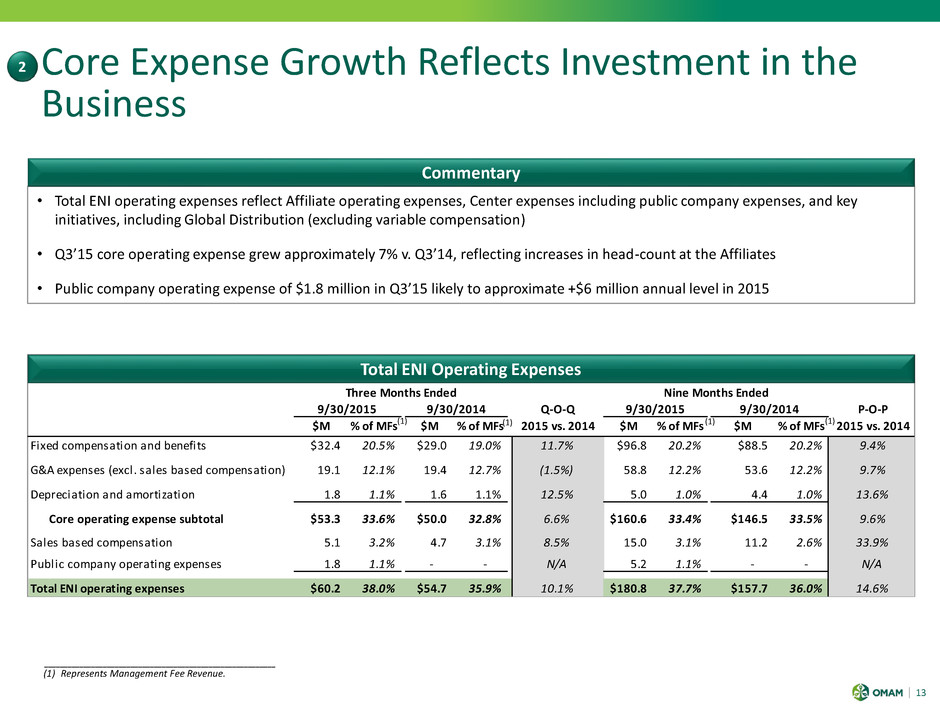
│ • Total ENI operating expenses reflect Affiliate operating expenses, Center expenses including public company expenses, and key initiatives, including Global Distribution (excluding variable compensation) • Q3’15 core operating expense grew approximately 7% v. Q3’14, reflecting increases in head-count at the Affiliates • Public company operating expense of $1.8 million in Q3’15 likely to approximate +$6 million annual level in 2015 Core Expense Growth Reflects Investment in the Business 13 2 (1) Represents Management Fee Revenue. Total ENI Operating Expenses Commentary (1) (1) ___________________________________________________________ (1) (1) Q-O-Q P-O-P $M % of MFs $M % of MFs 2015 vs. 2014 $M % of MFs $M % of MFs 2015 vs. 2014 Fix d compe sation and benefits $32.4 20.5% $29.0 19.0% 11.7% $96.8 20.2% $88.5 20.2% 9.4% G&A expenses (excl. sales based compensation) 19.1 12.1% 19.4 12.7% (1.5%) 58.8 12.2% 53.6 12.2% 9.7% Depreciation and amortization 1.8 1.1% 1.6 1.1% 12.5% 5.0 1.0% 4.4 1.0% 13.6% Core operating expense subtotal $53.3 33.6% $50.0 32.8% 6.6% $160.6 33.4% $146.5 33.5% 9.6% Sales based compensation 5.1 3.2% 4.7 3.1% 8.5% 15.0 3.1% 11.2 2.6% 33.9% Public company operating expenses 1.8 1.1% - - N/A 5.2 1.1% - - N/A Total ENI operating expenses $60.2 38.0% $54.7 35.9% 10.1% $180.8 37.7% $157.7 36.0% 14.6% 9/30/2015 9/30/2014 9/30/2015 9/30/2014 Three Months Ended Nine Months Ended

│ • Variable compensation typically awarded based on contractual percentage (e.g., ~25 – 30%) of each Affiliate’s ENI earnings before variable compensation, plus Center bonuses ‒ Affiliate variable compensation includes cash and equity provided through recycling ‒ Center variable compensation includes cash and OMAM equity • Slightly higher Q3’15 Variable Compensation Ratio v. Q3’14 reflects enhanced scale at Center and certain Affiliates, offset by public company related variable compensation • Public company related variable compensation of approximately $0.9 million in Q3; likely to have a full-year 2015 impact of approximately $3 million related to new hires and 2015 – 2017 LTIP Variable Compensation Aligned With Business Performance 14 3 Please see definitions and additional notes. Variable Compensation Commentary ___________________________________________________________ Q-O-Q P-O-P $M 9/30/2015 9/30/2014 2015 vs. 2014 9/30/2015 9/30/2014 2015 vs. 2014 Ca h variable compensation $38.9 $39.4 (1.3%) $115.2 $110.9 3.9% Add: Non-cash equity-based award amortization 6.0 4.3 39.5% 16.8 13.0 29.2% Vari ble compensation $44.9 $43.7 2.7% $132.0 $123.9 6.5% Earnings before variable compensation $105.7 $104.3 1.3% $316.2 $293.3 7.8% Variable Compensation Ratio (VC as % of earnings before variable comp.) 42.5% 41.9% 58 bps 41.7% 42.2% -50 bps Note: Public company related variable compensation (included above): 0.9 - N/A 2.2 - N/A Three Months Ended Nine Months Ended
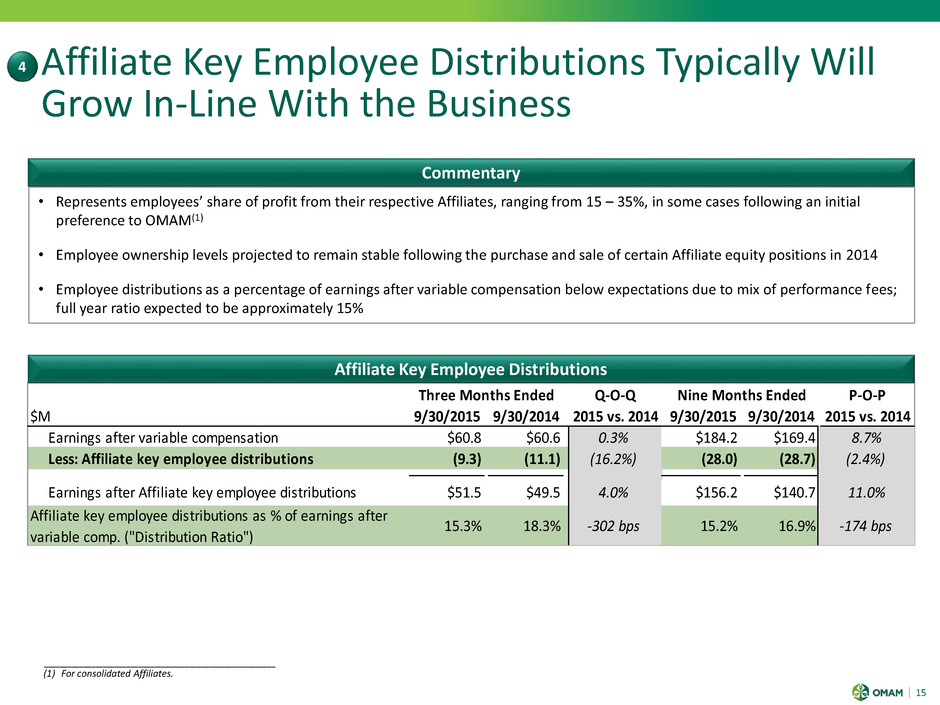
│ • Represents employees’ share of profit from their respective Affiliates, ranging from 15 – 35%, in some cases following an initial preference to OMAM(1) • Employee ownership levels projected to remain stable following the purchase and sale of certain Affiliate equity positions in 2014 • Employee distributions as a percentage of earnings after variable compensation below expectations due to mix of performance fees; full year ratio expected to be approximately 15% ___________________________________________________________ Affiliate Key Employee Distributions Typically Will Grow In-Line With the Business 15 4 (1) For consolidated Affiliates. Affiliate Key Employee Distributions Commentary B A ( / ) AB Q-O-Q P-O-P $M 9/30/2015 9/30/2014 2015 vs. 2014 9/30/2015 9/30/2014 2015 vs. 2014 Earnings after variable compensation $60.8 $60.6 0.3% $184.2 $169.4 8.7% Less: Affiliate key employee distributions (9.3) (11.1) (16.2%) (28.0) (28.7) (2.4%) Earnings after Affiliate key employee distributions $51.5 $49.5 4.0% $156.2 $140.7 11.0% 15.3% 18.3% -302 bps 15.2% 16.9% -174 bps Affiliate key employee distributions as % of earnings after variable comp. ("Distribution Ratio") Nine Months EndedThree Months Ended

│ • In the nine months ended 2015, repaid $37 million Notes payable to related parties and $107 million drawn on revolving credit facility • $70 million currently drawn on OMAM’s $350 million revolving credit facility • Leverage ratio (Debt / EBITDA) of 0.3x well below 3.0x covenant limit • $143 million seed capital pool provided by Old Mutual plc—off balance sheet to OMAM • $0.08 per share interim dividend approved • Payable December 29 to shareholders of record as of December 11 • Reflects 25% payout rate • Dividends expected to be paid at the end of each quarter ($M ) September 30, 2015 (U.S. GAAP) Excluding Consolidated Funds (Non-GAAP) Including Consolidated Funds (U.S. GAAP) Assets Cash and cash equivalents 126.8$ 175.6$ 175.6$ Investment advisory fees receivable 145.3 165.1 161.1 Investments 152.2 149.3 149.3 Other assets 487.6 503.2 503.2 Assets of Consolidated Funds - - 6,783.7 Total assets 911.9$ 993.2$ 7,772.9$ Liabilities and shareholders' equity Accounts payable and accrued expenses 160.1$ 171.6$ 171.6$ Due to related parties 239.9 289.9 289.9 Notes payable to related parties - 37.0 37.0 Third party borrowings 70.0 177.0 177.0 Other l iabilities 317.7 281.2 281.2 Liabilities of Consolidated Funds - - 4,258.8 Total liabilities 787.7 956.7 5,215.5 Total equity 124.2 36.5 2,557.4 Total liabilities and equity 911.9$ 993.2$ 7,772.9$ Shares outstanding: Basic 120.0 120.0 120.0 Diluted(1) 120.5 120.0 120.0 December 31, 2014 Balance Sheet Can Be Leveraged To Grow Business 16 Dividend • New fund consolidation guidance adopted by OMAM in 2015 results in removal of Consolidated Funds from GAAP balance sheet and income statement ___________________________________________________________ Please see definitions and additional notes. (1) Diluted shares expected to be approximately 120.5 million for Q4 2015, assuming no issuance of primary equity. Balance Sheet Capital

Appendix 17

│ $m 2015 2014 2015 2014 U.S. GAAP net income attributable to controlling interests $35.0 ($1.7) $118.6 $17.4 Adjustments for restructuring & reorganization related to IPO: i. Non-cash notional parent corporate cost allocation - 1.8 - 3.4 ii. Intercompany interest expense - 16.6 - 49.8 iii. Co-investment (gain) - (0.5) - (2.6) Total restructuring and reorganization adjustments $0.0 $17.9 $0.0 $50.6 Adjustments to reflect the economic earnings of the Company: iv. Non-cash Key employee-owned equity and profit interest revaluations 2.7 40.2 14.0 57.1 v. Amortization of goodwill and acquired intangibles - - 0.1 0.1 vii. Capital transaction costs 1.6 - 1.6 - viii. Discontinued operations and restructuring costs (1.0) (0.9) (1.9) 5.4 Total adjustment to reflect earnings of the Company $3.3 $39.3 $13.8 $62.6 Less: Tax effect of above adjustments (1.7) (16.2) (6.3) (22.8) Less: ENI tax normalization 1.3 (1.7) (1.5) (3.5) Economic net income (including extraordinary performance fee) $37.9 $37.6 $124.6 $104.3 Extraordinary performance fee - - (11.4) - Economic net income excluding extraordinary performance fee $37.9 $37.6 $113.2 $104.3 Net interest (income) expense 0.5 - 2.0 (0.1) Depreciation and amortization 1.8 1.6 5.0 4.4 Tax on Economic Net Income 13.1 11.9 41.0 36.5 Adjusted EBITDA excluding extraordinary performance fee $53.3 $51.1 $161.2 $145.1 September 30, Three Months Ended Nine Months Ended September 30, i. Exclude notional non-cash corporate cost allocations ii. Exclude interest expense historically paid to OM plc as the related debt was restructured in connection with the Offering and thereafter has been eliminated from consolidated results iii. Exclude historical mark-to-market co-investment gains and losses as co-investments and ongoing returns have been wholly allocated to OM plc in connection with the Offering v. Exclude non-cash expenses representing changes in the value of Affiliate equity and profit interests held by Affiliate key employees vi. Exclude amortization or impairment expenses related to acquired goodwill and other intangibles as they represent non-cash charges that do not result in an outflow of tangible economic benefits from the business vii. Exclude capital transaction costs viii. Exclude results of discontinued operations attributable to controlling interests as they are not part of the ongoing business, and restructuring costs incurred in continuing operations which represent an exit from a distinct product or line of business ix. Exclude one-off tax benefits or costs unrelated to current operations Reconciliation: GAAP to ENI and Adjusted EBITDA 18 (1) Tax-affected items for which adjustments are included in “Tax effect of above adjustments” line; taxed at 40.2% U.S. statutory rate (including state tax). (2) Includes $31.6 million related to the purchase of additional ownership interests in an Affiliate. 1 2 4 5 6 ENI Adjustments 1 2 3 4 5 6 7 8 (1) (1) (1) (1) ___________________________________________________________ 3 8 7 (1) (2) (2)

│ Definitions and Additional Notes 19 References to “OMAM” or the “Company” refer to OM Asset Management plc; references to the “Parent” or “Old Mutual” refer to Old Mutual plc; references to the “Offering” refer to the Company’s initial public offering dated October 8, 2014 and references to the “Prospectus” refer to the Company’s Prospectus dated as of that date; references to the “Reorganization” refer to the steps taken by OMAM’s Parent prior to the Offering to reorganize the ownership of the business, as described in the Company’s Prospectus. Economic Net Income The Company uses a non-GAAP performance measure referred to as economic net income (“ENI”) to represent its view of the underlying economic earnings of the business. ENI is used to make resource allocation decisions, determine appropriate levels of investment or dividend payout, manage balance sheet leverage, determine Affiliate variable compensation and equity distributions, and incentivize management. The Company’s ENI adjustments to U.S. GAAP include both reclassifications of U.S. GAAP revenue and expense items, as well as adjustments to U.S. GAAP results, primarily to exclude non-cash, non-economic expenses, or to reflect cash benefits not recognized under U.S. GAAP. The Company re-categorizes certain line items on the income statement to: • exclude the effect of Fund consolidation by removing the portion of Fund revenues, expenses and investment return which is not attributable to its shareholders; • include within management fee revenue any fees paid to Affiliates by Consolidated Funds, which are viewed as investment income under U.S. GAAP; • include the Company’s share of earnings from equity-accounted Affiliates within other income, rather than investment income; • treat sales-based compensation as a general and administrative expense, rather than part of fixed compensation and benefits; • identify separately, the fixed and variable components of compensation and benefits expense; and • identify separately as Affiliate distributions the component of U.S. GAAP compensation that represents earnings shared with Affiliate key employee equity and profit-interest holders. To reflect the Reorganization which took place at the time of the Offering, the Company has excluded: i. notional corporate cost allocations which are non-cash expenses that will not recur following the Offering; ii. interest expense historically paid to the Parent, as the related debt was restructured in connection with the Offering and has been eliminated from consolidated results; and iii. historic mark-to-market co-investment gains and losses, because these investments and ongoing returns thereon have been allocated wholly to Old Mutual plc in connection with the Offering. The Company also makes the following adjustments to U.S. GAAP results to more closely reflect its economic results by excluding: iv. non-cash expenses representing changes in the value of Affiliate equity and profit interests held by Affiliate key employees. These ownerships interests may in certain circumstances be repurchased by OMAM at a value based on a pre-determined fixed multiple of trailing earnings and as such this value is carried on the Company’s balance sheet as a liability. Non-cash movements in the value of this liability are treated as compensation expense under U.S. GAAP. However, any equity or profit interests repurchased by OMAM can be used to fund a portion of future variable compensation awards, resulting in savings in cash variable compensation that offset the negative cash effect of repurchasing the equity. v. non-cash amortization or impairment expenses related to acquired goodwill and other intangibles as these are non-cash charges that do not result in an outflow of tangible economic benefits from the business. vi. capital transaction costs, including the costs of raising debt or equity, gains or losses realized as a result of redeeming debt or equity and direct incremental costs associated with acquisitions of businesses or assets. vii. the results of discontinued operations attributable to controlling interests since they are not part of the Company’s ongoing business, and restructuring costs incurred in continuing operations which represent an exit from a distinct product or line of business. viii. deferred tax resulting from changes in tax law and expiration of statutes, adjustments for uncertain tax positions, deferred tax attributable to intangible assets and other unusual items not related to current operating results to reflect ENI tax normalization. The Company adjusts its income tax expense to reflect any tax impact of its ENI adjustments. Please see Slide 18 for a reconciliation of net income attributable to controlling interests to economic net income. Adjusted EBITDA Adjusted EBITDA is defined as economic net income before interest, income taxes, depreciation and amortization. The Company notes that its calculation of Adjusted EBITDA may not be consistent with Adjusted EBITDA as calculated by other companies. The Company believes Adjusted EBITDA is a useful liquidity metric because it indicates the Company’s ability to make further investments in its business, service debt and meet working capital requirements. Please see Slide 18 for a reconciliation of economic net income to Adjusted EBITDA.
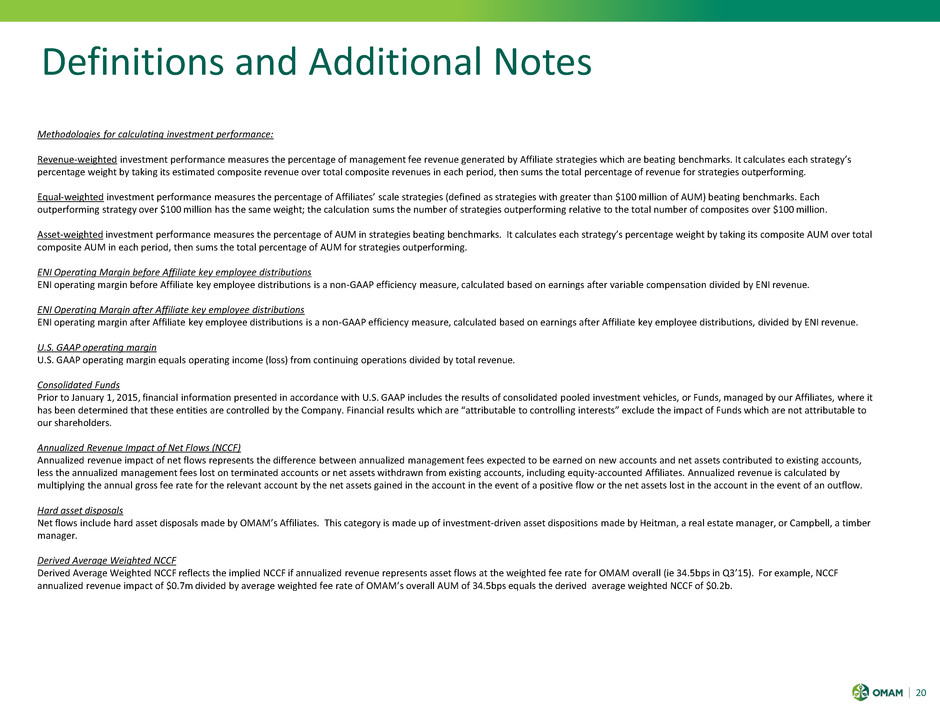
│ Definitions and Additional Notes 20 Methodologies for calculating investment performance: Revenue-weighted investment performance measures the percentage of management fee revenue generated by Affiliate strategies which are beating benchmarks. It calculates each strategy’s percentage weight by taking its estimated composite revenue over total composite revenues in each period, then sums the total percentage of revenue for strategies outperforming. Equal-weighted investment performance measures the percentage of Affiliates’ scale strategies (defined as strategies with greater than $100 million of AUM) beating benchmarks. Each outperforming strategy over $100 million has the same weight; the calculation sums the number of strategies outperforming relative to the total number of composites over $100 million. Asset-weighted investment performance measures the percentage of AUM in strategies beating benchmarks. It calculates each strategy’s percentage weight by taking its composite AUM over total composite AUM in each period, then sums the total percentage of AUM for strategies outperforming. ENI Operating Margin before Affiliate key employee distributions ENI operating margin before Affiliate key employee distributions is a non-GAAP efficiency measure, calculated based on earnings after variable compensation divided by ENI revenue. ENI Operating Margin after Affiliate key employee distributions ENI operating margin after Affiliate key employee distributions is a non-GAAP efficiency measure, calculated based on earnings after Affiliate key employee distributions, divided by ENI revenue. U.S. GAAP operating margin U.S. GAAP operating margin equals operating income (loss) from continuing operations divided by total revenue. Consolidated Funds Prior to January 1, 2015, financial information presented in accordance with U.S. GAAP includes the results of consolidated pooled investment vehicles, or Funds, managed by our Affiliates, where it has been determined that these entities are controlled by the Company. Financial results which are “attributable to controlling interests” exclude the impact of Funds which are not attributable to our shareholders. Annualized Revenue Impact of Net Flows (NCCF) Annualized revenue impact of net flows represents the difference between annualized management fees expected to be earned on new accounts and net assets contributed to existing accounts, less the annualized management fees lost on terminated accounts or net assets withdrawn from existing accounts, including equity-accounted Affiliates. Annualized revenue is calculated by multiplying the annual gross fee rate for the relevant account by the net assets gained in the account in the event of a positive flow or the net assets lost in the account in the event of an outflow. Hard asset disposals Net flows include hard asset disposals made by OMAM’s Affiliates. This category is made up of investment-driven asset dispositions made by Heitman, a real estate manager, or Campbell, a timber manager. Derived Average Weighted NCCF Derived Average Weighted NCCF reflects the implied NCCF if annualized revenue represents asset flows at the weighted fee rate for OMAM overall (ie 34.5bps in Q3’15). For example, NCCF annualized revenue impact of $0.7m divided by average weighted fee rate of OMAM’s overall AUM of 34.5bps equals the derived average weighted NCCF of $0.2b.
